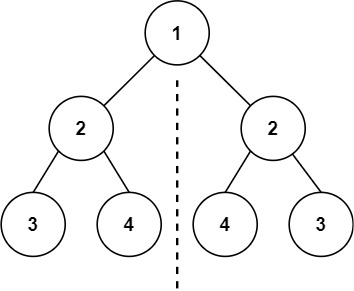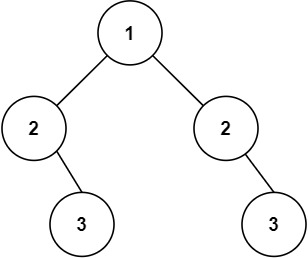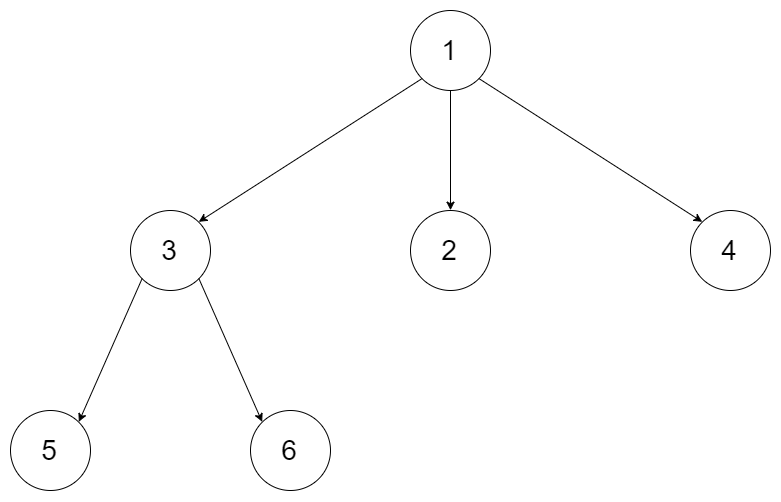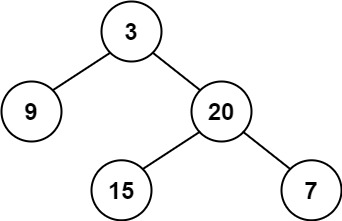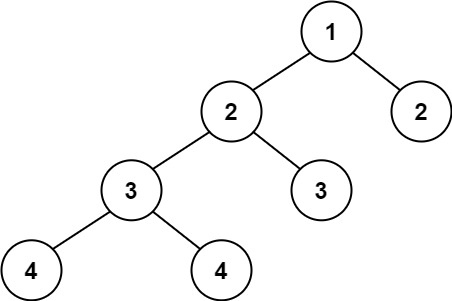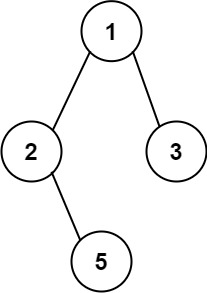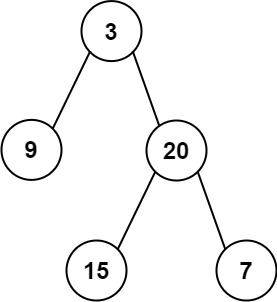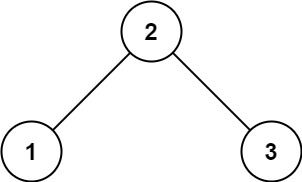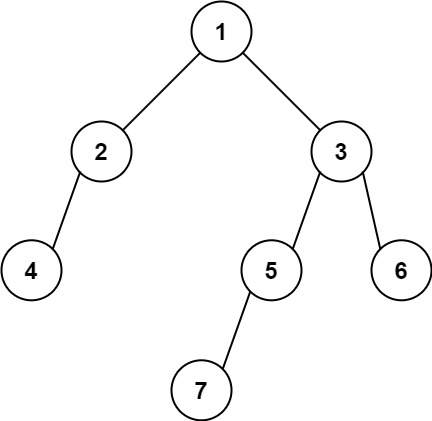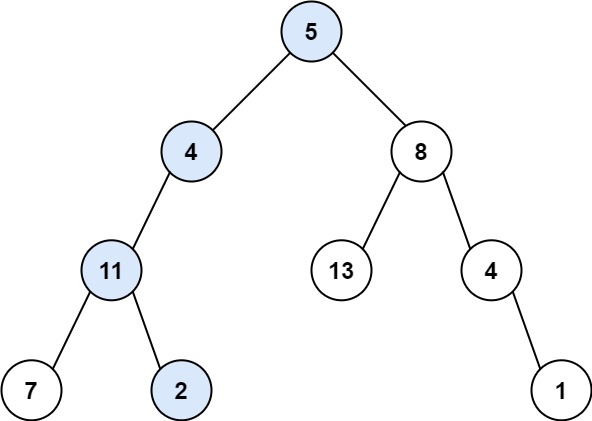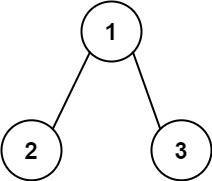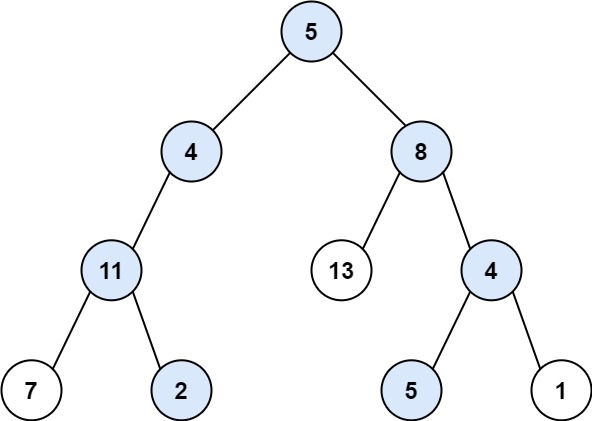 二叉树(中)
二叉树(中)
# 二叉树(中)
# 六、翻转二叉树
226. 翻转二叉树 - 力扣(LeetCode) (opens new window)
# 1、题目
给你一棵二叉树的根节点 root ,翻转这棵二叉树,并返回其根节点。
示例 1: 输入:root = [4,2,7,1,3,6,9] 输出:[4,7,2,9,6,3,1]1
2
3
4
示例 2: 输入:root = [2,1,3] 输出:[2,3,1]1
2
3示例 3: 输入:root = [] 输出:[]1
2
3
4提示:
- 树中节点数目范围在
[0, 100]内-100 <= Node.val <= 100
# 2、思路
- 这道题的思路很简单,就是遍历每一个节点,然后对他们的左右指针进行交换,所以写法有很多,比较需要注意的是递归的中序写法
- 上面加粗这句很重要,是解题的核心
- 这也是为什么所有所有遍历方式基本都可以的原因,因为我们这道题的核心就是要遍历每个节点而已
- 题目给出的节点定义
/**
* Definition for a binary tree node.
* struct TreeNode {
* int val;
* struct TreeNode *left;
* struct TreeNode *right;
* };
*/
2
3
4
5
6
7
8
9
# 3、自己胡乱写的递归😫
//写的时候看到函数有返回值,就想着得有个变量去接收函数调用时的返回值,然后就写的奇奇怪怪的,虽然好像是后序遍历的感觉,但总觉得奇奇怪怪的😰😰😰
struct TreeNode* invertTree(struct TreeNode* root){
if(root==NULL){
return NULL ;
}
struct TreeNode * l_node = invertTree(root->left);
struct TreeNode * r_node = invertTree(root->right);
root -> left = r_node;
root -> right = l_node;
return root;
}
2
3
4
5
6
7
8
9
10
11
12
13
# 4、深度遍历递归
//递归写法的深度遍历,前后遍历都可以,但是中序遍历不行,如果一定要把交换操作放在中间处理的话,那么两次调用递归函数传入的指针必须都为左或右指针,因为中间处理过后,指针被翻转了,那么就变成了 左中左,或者右中右的遍历,就不符合中序遍历定义了
//以下为前序遍历
struct TreeNode* invertTree(struct TreeNode* root){
if(root == NULL){
return root;
}
struct TreeNode* node = root->left; //中
root ->left = root ->right;
root->right = node;
invertTree(root ->left); //左
invertTree(root ->right); //右
return root;
}
2
3
4
5
6
7
8
9
10
11
12
13
# 5、统一写法的深度遍历
//统一写法深度遍历(我称之为空指针标志法),前中后序都可以
struct TreeNode* invertTree(struct TreeNode* root){
if(root == NULL){
return root;
}
struct TreeNode * stack[200];
int top=0;
stack[top++] =root;
while(top>0){
//注意获取栈顶元素要栈顶指针减一
struct TreeNode* node= stack[top-1];
if(node != NULL){
top--; //出栈
if(node -> right) stack[top++] = node ->right; // 右
stack[top++]= node;// 中
stack[top++]= NULL;
if(node -> left) stack[top++] = node ->left; // 左
//右中左出栈就为 左中右即中序遍历
}
else {
top--; //遇到NULL就弹出,并进行处理
node = stack[--top];
struct TreeNode * temp = node->left;
node->left = node->right;
node->right = temp;
}
}
return root;
}
2
3
4
5
6
7
8
9
10
11
12
13
14
15
16
17
18
19
20
21
22
23
24
25
26
27
28
29
30
31
# 6、层序遍历
struct TreeNode* invertTree(struct TreeNode* root){
if(root==NULL){
return NULL ;
}
struct TreeNode* queue[100];
int front=0,rear=0;
queue[rear++] =root;
while(front != rear){
int size = rear - front;
for(int i=0;i<size;i++){
struct TreeNode * node = queue[front++];
//交换左右指针
struct TreeNode * temp = node ->left;
node ->left = node-> right;
node ->right = temp;
//下面哪个先进没区别,因为我们主要是要遍历每个结点然后交他们的左右指针而已
if(node->right) queue[rear++] = node->right;
if(node->left) queue[rear++] = node->left;
}
}
return root;
}
2
3
4
5
6
7
8
9
10
11
12
13
14
15
16
17
18
19
20
21
22
23
24
25
# 七、对称二叉树
101. 对称二叉树 - 力扣(LeetCode) (opens new window)
# 1、题目
给你一个二叉树的根节点
root, 检查它是否轴对称。
示例 1: 输入:root = [1,2,2,3,4,4,3] 输出:true1
2
3
示例 2: 输入:root = [1,2,2,null,3,null,3] 输出:false1
2
3提示:
- 树中节点数目在范围
[1, 1000]内-100 <= Node.val <= 100
# 2、递归思路
# 2.1 确定递归函数的参数和返回值
因为我们要比较的是根节点的两个子树是否是相互翻转的,进而判断这个树是不是对称树,所以要比较的是两个树,参数自然也是左子树节点和右子树节点。
返回值自然是bool类型。
代码如下:
bool compare(TreeNode* left, TreeNode* right)
# 2.2 确定终止条件
要比较两个节点数值相不相同,首先要把两个节点为空的情况弄清楚!否则后面比较数值的时候就会操作空指针了。
节点为空的情况有:(注意我们比较的其实不是左孩子和右孩子,所以如下我称之为左节点右节点)
左节点为空,右节点不为空,不对称,return false
左不为空,右为空,不对称 return false
左右都为空,对称,返回true
此时已经排除掉了节点为空的情况,那么剩下的就是左右节点不为空:
- 左右都不为空,比较节点数值,不相同就return false
此时左右节点不为空,且数值也不相同的情况我们也处理了。
代码如下:
if (left == NULL && right != NULL) return false;
else if (left != NULL && right == NULL) return false;
else if (left == NULL && right == NULL) return true;
else if (left->val != right->val) return false; // 注意这里我没有使用else
2
3
4
- 注意上面最后一种情况,我没有使用else,而是else if, 因为我们把以上情况都排除之后,剩下的就是 左右节点都不为空,且数值相同的情况。
# 2.3 确定单层递归的逻辑
此时才进入单层递归的逻辑,单层递归的逻辑就是处理 左右节点都不为空,且数值相同的情况。
比较二叉树外侧是否对称:传入的是左节点的左孩子,右节点的右孩子。
比较内测是否对称,传入左节点的右孩子,右节点的左孩子。
如果左右都对称就返回true ,有一侧不对称就返回false 。
代码如下:
bool outside = compare(left->left, right->right); // 左子树:左、 右子树:右
bool inside = compare(left->right, right->left); // 左子树:右、 右子树:左
bool isSame = outside && inside; // 左子树:中、 右子树:中(逻辑处理)
return isSame;
2
3
4
# 3、递归代码
//递归写法
bool compare(struct TreeNode* left,struct TreeNode* right){
//先排除空节点的情况
if (left == NULL && right!=NULL) return false;
else if (left!=NULL && right ==NULL) return false;
else if (left == NULL && right == NULL) return true;
//排除无空节点,但数组不同情况
else if (left->val != right ->val) return false;
//剩下就是左右节点不为空,且数组相同
//此时才做递归,做下一层判断
bool outside = compare(left->left,right ->right); //左子树:左、右子树:右
bool inside = compare(left->right,right ->left); //左子树:右、右子树:左
bool isSame = outside && inside; //左子树:中、右子树:中(逻辑处理)
return isSame;
}
bool isSymmetric(struct TreeNode* root){
if(root == NULL) return true;
return compare(root->left,root->right);
}
2
3
4
5
6
7
8
9
10
11
12
13
14
15
16
17
18
19
20
21
22
# 4、迭代思路
- 因为这道题的迭代使用队列或者栈都是一个思路,写发也区别不大,所以就用队列来讲解思路
- 通过队列来判断根节点的左子树和右子树的内侧和外侧是否相等,如动画所示:

- 简单来说: 就是把要判断的一对一起放进队列/栈里,判断处理时也一起出队/栈
- 注意处理时, 判断节点都为空就
continue跳过; - 遇到不对称情况就直接返回
false; - 除此之外 , 正常两个节点的子节点进队/栈,同时放回
true
- 注意处理时, 判断节点都为空就
# 5、迭代代码
//队列写法,要比较的一对一对进队,出队处理
bool isSymmetric(struct TreeNode* root){
if(root == NULL) return true;
struct TreeNode* queue[1000];
int front=0,rear=0;
queue[rear++] = root->left;
queue[rear++] = root->right;
while(front != rear){
struct TreeNode* l_node = queue[front++];
struct TreeNode* r_node = queue[front++];
//左右节点都都为空
if(!l_node && !r_node) continue;
// 左右节点有一个为空,或者都不为空但数组不同
if(!l_node || !r_node || (l_node ->val != r_node ->val)){
return false;
}
queue[rear++] = l_node->left;
queue[rear++] = r_node->right;
queue[rear++] = l_node->right;
queue[rear++] = r_node->left;
}
return true;
}
2
3
4
5
6
7
8
9
10
11
12
13
14
15
16
17
18
19
20
21
22
23
24
25
26
27
28
//栈写法,要比较的一对一对进栈,出队处理 (和队列没有太大区别)
bool isSymmetric(struct TreeNode* root){
if(root == NULL) return true;
struct TreeNode* stack[1000];
int top=0;
stack[top++] = root->left;
stack[top++] = root->right;
while(top>0){
struct TreeNode* l_node = stack[--top];
struct TreeNode* r_node = stack[--top];
//左右节点都都为空
if(!l_node && !r_node) continue;
// 左右节点有一个为空,或者都不为空但数组不同
if(!l_node || !r_node || (l_node ->val != r_node ->val)){
return false;
}
stack[top++] = l_node->left;
stack[top++] = r_node->right;
stack[top++] = l_node->right;
stack[top++] = r_node->left;
}
return true;
}
2
3
4
5
6
7
8
9
10
11
12
13
14
15
16
17
18
19
20
21
22
23
24
25
26
27
# 6、相似题
# 6.1 100.相同的树
- 100. 相同的树 - 力扣(LeetCode) (opens new window)
- 思路:与对称二叉树相似,但是不是按里侧外侧来判断,而是左对左,右对右的判断
# 6.2 572.另一个树的子树😣
- 思路:这题比较难,用了双重递归,先递归找到与子树根结点数组相同的结点,然后再递归判断子树是否完全相同
# 八、N叉树的最大深度
559. N 叉树的最大深度 - 力扣(LeetCode) (opens new window)
代码随想录 (programmercarl.com) (opens new window)
- 上面链接虽然是二叉树的最大深度,但是也有N叉树的
# 1、题目
给定一个 N 叉树,找到其最大深度。
最大深度是指从根节点到最远叶子节点的最长路径上的节点总数。
N 叉树输入按层序遍历序列化表示,每组子节点由空值分隔(请参见示例)。
示例 1: 输入:root = [1,null,3,2,4,null,5,6] 输出:31
2
3
4提示:
- 树的深度不会超过
1000。- 树的节点数目位于
[0, 104]之间。/** * Definition for a Node. * struct Node { * int val; * int numChildren; * struct Node** children; * }; */1
2
3
4
5
6
7
8
# 2、递归
# 2.1 思路与代码
- 递归到每个子结点的最深层,然后判断深度,再加1 ,就得到了N叉树的最大深度
//递归
int maxDepth(struct Node* root) {
//终止条件
if( root == NULL) return 0;
//递归处理
int depth = 0;
for(int i=0;i<root->numChildren;i++){
int newdepth = maxDepth(root->children[i]);
depth = depth > newdepth ? depth : newdepth;
}
return depth+1;
}
2
3
4
5
6
7
8
9
10
11
12
# 3、迭代
# 3.1 思路与代码
- 一层一层入队,每进一层,深度加一
//队列写法
int maxDepth(struct Node* root) {
if(root == NULL) return 0;
struct Node* queue[10000];
int front=0,rear=0;
queue[rear++] = root;
int depth=0;
while(front != rear)
{
int size = rear - front;
for(int i=0;i<size;i++)
{
struct Node * node = queue[front++];
for(int k=0;k < node-> numChildren; k++)
{
queue[rear++] = node->children[k];
}
}
depth++;
}
return depth;
}
2
3
4
5
6
7
8
9
10
11
12
13
14
15
16
17
18
19
20
21
22
23
# 九、完全二叉树
222. 完全二叉树的节点个数 - 力扣(LeetCode) (opens new window)
代码随想录 (programmercarl.com) (opens new window)
# 1、题目
给你一棵 完全二叉树 的根节点 root ,求出该树的节点个数。
完全二叉树 的定义如下:在完全二叉树中,除了最底层节点可能没填满外,其余每层节点数都达到最大值,并且最下面一层的节点都集中在该层最左边的若干位置。若最底层为第 h 层,则该层包含 1~ 2h 个节点。
示例 1: 输入:root = [1,2,3,4,5,6] 输出:6 示例 2: 输入:root = [] 输出:0 示例 3: 输入:root = [1] 输出:11
2
3
4
5
6
7
8
9
10
11提示:
- 树中节点的数目范围是
[0, 5 * 104]0 <= Node.val <= 5 * 104- 题目数据保证输入的树是 完全二叉树
# 2、递归思路及代码
- 后序递归遍历,先求它的左子树的节点数量,再求右子树的节点数量,最后取总和再加一 (加1是因为算上当前中间节点)就是目前节点为根节点的节点数量
int countNodes(struct TreeNode* root){
//递归终止条件
if(root == NULL){
return 0;
}
int leftnum = countNodes(root->left); //左
int rightnum = countNodes(root -> right); //右
return 1+ leftnum +rightnum; //中
}
2
3
4
5
6
7
8
9
10
11
# 3、迭代法思路及代码
- 遍历每个节点,记录数值加一
//栈,迭代
int countNodes(struct TreeNode* root){
if(root == NULL) return 0;
struct TreeNode* stack[25000];
int top=0;
stack[top++] = root;
int count=0;
while(top > 0){
struct TreeNode* node = stack[--top];
count++;
if(node ->left) stack[top++] = node ->left;
if(node ->right) stack[top++] = node ->right;
}
return count;
}
2
3
4
5
6
7
8
9
10
11
12
13
14
15
16
//迭代,队列
int countNodes(struct TreeNode* root){
int count=0;
if(root == NULL) return count;
struct TreeNode * queue[50000];
int front=0,rear=0;
queue[rear++] = root;
count++;
while(front != rear){
int size= rear -front;
for(int i=0;i<size;i++){
struct TreeNode * node = queue[front++];
if(node -> left) {
queue[rear++] = node -> left;
count++;
}
if(node -> right) {
queue[rear++] = node -> right;
count++;
}
}
}
return count;
}
2
3
4
5
6
7
8
9
10
11
12
13
14
15
16
17
18
19
20
21
22
23
24
25
# 4、完全二叉树性质解法
这道题给我们的就是完全二叉树,所以我们可以利用完全二叉树的性质来解
完全二叉树只有两种情况,情况一:就是满二叉树,情况二:最后一层叶子节点没有满。
- 对于情况一,可以直接用 2^树深度 - 1 来计算,注意这里根节点深度为1。
- 对于情况二,分别递归左孩子,和右孩子,递归到某一深度一定会有左孩子或者右孩子为满二叉树,然后依然可以按照情况1来计算。
完全二叉树(一)如图:
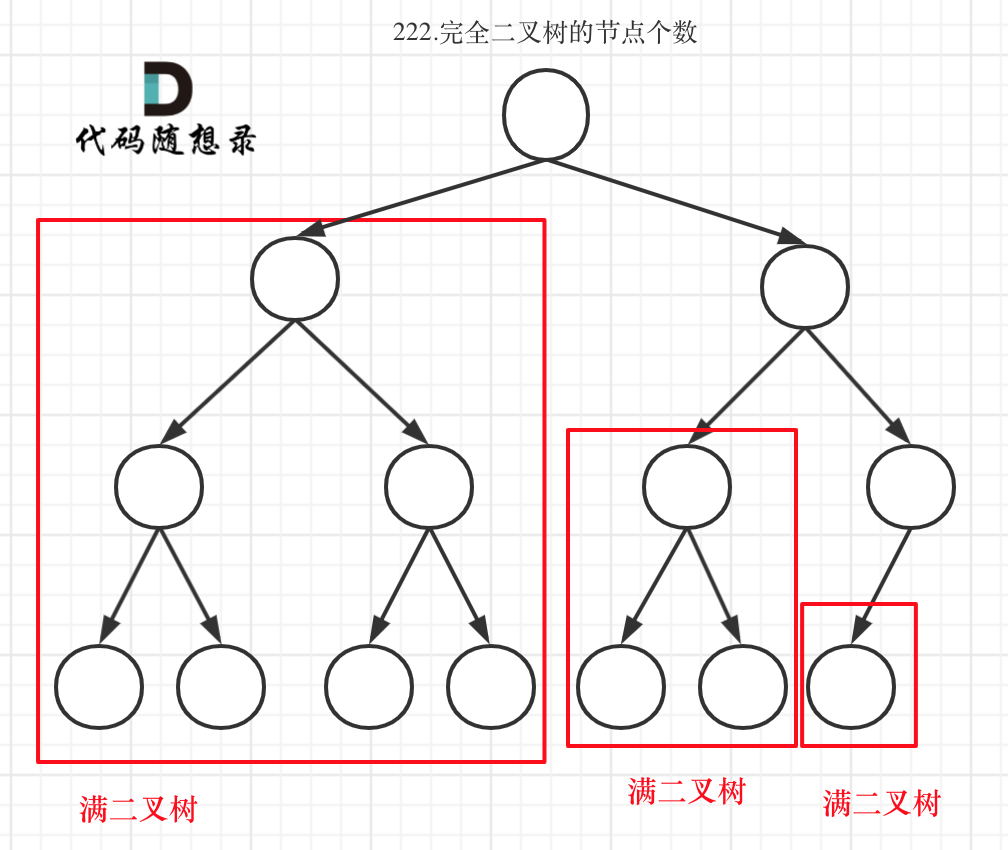
- 完全二叉树(二)如图:
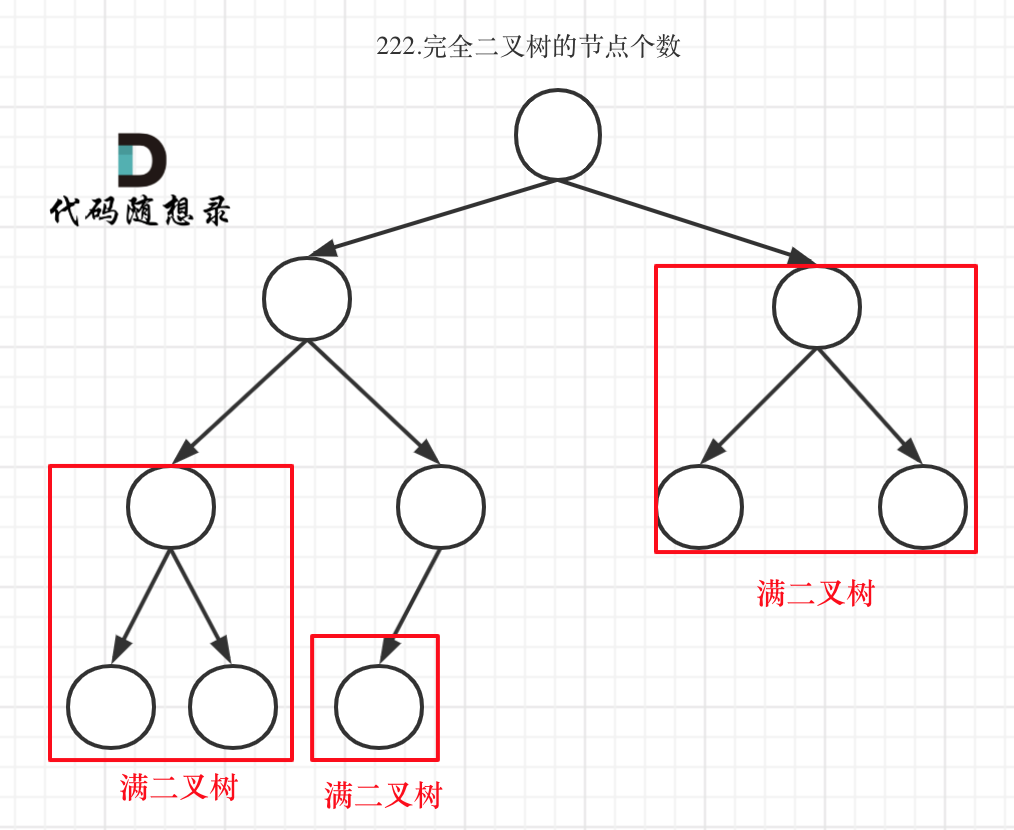
- 可以看出如果整个树不是满二叉树,就递归其左右孩子,直到遇到满二叉树为止,用公式计算这个子树(满二叉树)的节点数量。
- 这里关键在于如何去判断一个左子树或者右子树是不是满二叉树呢?
- 在完全二叉树中,如果递归向左遍历的深度等于递归向右遍历的深度,那说明就是满二叉树。如图:
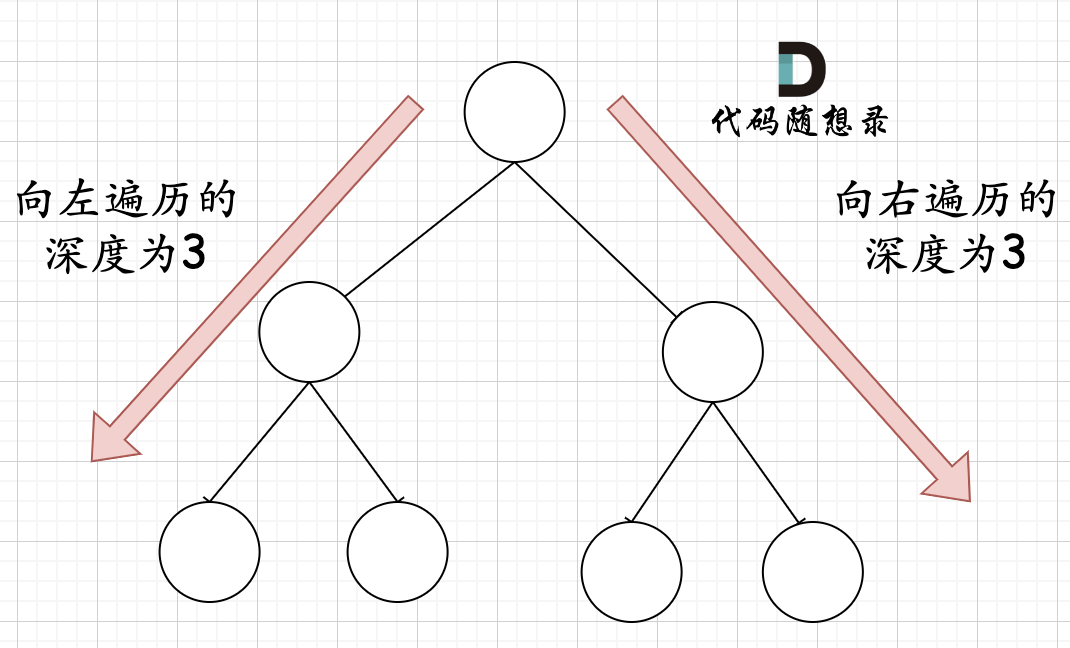
- 注意:下图虽然递归向左遍历的深度和向右深度相同,但并不是满二叉树,因为它甚至不是完全二叉树,本题给我们的树本身就是完全二叉树,所以我们才可以使用这种判断左右深度的方法来解题
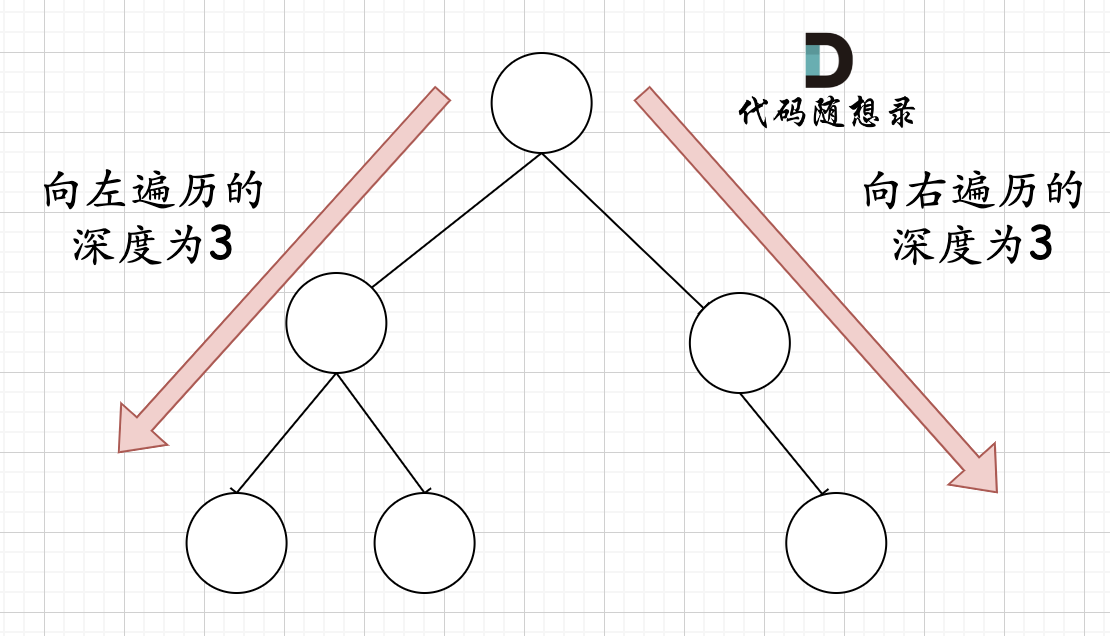
//完全二叉树性质
int countNodes(struct TreeNode* root){
//递归终止条件
if(root==NULL)
return 0;
int leftDepth = 0;
int rightDepth = 0;
struct TreeNode* leftnode =root ->left;
struct TreeNode* rightnode =root ->right;
//求出左子树深度
while(leftnode){
leftnode = leftnode ->left;
leftDepth++;
}
//求出右子树深度
while(rightnode){
rightnode = rightnode ->right;
rightDepth++;
}
//若左右子树深度相同,为满二叉树。结点个数为 2^height-1
if(rightDepth == leftDepth){
if(leftDepth == 0)
//用左移来计算平方
return (2 << leftDepth) -1;
}
//否则返回左右子树的结点个数 +1
return countNodes(root -> right) + countNodes(root -> left) + 1;
}
2
3
4
5
6
7
8
9
10
11
12
13
14
15
16
17
18
19
20
21
22
23
24
25
26
27
28
29
30
31
32
# 十、平衡二叉树
# 1、题目
给定一个二叉树,判断它是否是高度平衡的二叉树。
本题中,一棵高度平衡二叉树定义为:
一个二叉树每个节点 的左右两个子树的高度差的绝对值不超过 1 。
示例 1: 输入:root = [3,9,20,null,null,15,7] 输出:true1
2
3
4
示例 2: 输入:root = [1,2,2,3,3,null,null,4,4] 输出:false1
2
3
4示例 3: 输入:root = [] 输出:true1
2
3提示:
树中的节点数在范围
[0, 5000]内 -104 <=Node.val<= 104
# 2、递归思路
注意一个概念:
二叉树节点的深度:指从根节点到该节点的最长简单路径边的条数。
- 求深度一般用的(前序遍历)
- 求二叉树的最大深度 (opens new window) 这题用后序遍历是因为,我们这求得就相当于是求根节点的高度
class Solution { public: int result; void getDepth(TreeNode* node, int depth) { result = depth > result ? depth : result; // 中 if (node->left == NULL && node->right == NULL) return ; if (node->left) { // 左 depth++; // 深度+1 getDepth(node->left, depth); depth--; // 回溯,深度-1 } if (node->right) { // 右 depth++; // 深度+1 getDepth(node->right, depth); depth--; // 回溯,深度-1 } return ; } int maxDepth(TreeNode* root) { result = 0; if (root == NULL) return result; getDepth(root, 1); return result; } };1
2
3
4
5
6
7
8
9
10
11
12
13
14
15
16
17
18
19
20
21
22
23
24
25
26
27二叉树节点的高度:指从该节点到叶子节点的最长简单路径边的条数。
- 求高度一般用(后序遍历)
经过上面分析,我们判断出这道题也需要用后序遍历
- 主要的思路就是,递归遍历每个节点,获取其左右子节点的高度,然后进行比较,要是不满足平衡二叉树的规则,那么就一直返回 -1,否则返回根节点的高度
# 3、递归代码
int height(struct TreeNode * root){
//递归终止条件
if(root ==NULL) return 0;
//递归处理
int left_h = height(root ->left);
int right_h = height(root ->right);
//遇到一次不满足后一直返回 -1
if(fabs(left_h - right_h) >1 || left_h == -1 ||right_h ==-1){
return -1;
}
//计算高度
else {
int height = left_h > right_h ? left_h : right_h;
return height +1;
}
}
bool isBalanced(struct TreeNode* root){
return height(root) > -1;
}
2
3
4
5
6
7
8
9
10
11
12
13
14
15
16
17
18
19
20
21
# 4、 迭代思路
- 在104.二叉树的最大深度 (opens new window) (opens new window)中我们可以使用层序遍历来求深度,但是就不能直接用层序遍历来求高度了,这就体现出求高度和求深度的不同。
- 本题的迭代方式可以先定义一个函数,专门用来求高度。
- 这个函数通过栈模拟的后序遍历找每一个节点的高度(其实是通过求传入节点为根节点的最大深度来求的高度)
- 然后再用栈来模拟后序遍历,遍历每一个节点的时候,再去判断左右孩子的高度是否符合,代码如下:
//计算结点深度
int getDepth(struct TreeNode* node) {
//开辟栈空间
struct TreeNode** stack = (struct TreeNode**)malloc(sizeof(struct TreeNode*) * 10000);
int stackTop = 0;
//若传入结点存在,将其入栈。若不存在,函数直接返回0
if(node)
stack[stackTop++] = node;
int result = 0;
int depth = 0;
//当栈中有元素时,进行迭代遍历
while(stackTop) {
//取出栈顶元素
struct TreeNode* tempNode = stack[--stackTop];
//若栈顶元素非NULL,则将深度+1
if(tempNode) {
depth++;
//将栈顶元素再次入栈,添加NULL表示此结点已被遍历
stack[stackTop++] = tempNode;
stack[stackTop++] = NULL;
//若栈顶元素有左右孩子,则将孩子结点入栈
if(tempNode->left)
stack[stackTop++] = tempNode->left;
if(tempNode->right)
stack[stackTop++] = tempNode->right;
//更新结果
result = result > depth ? result : depth;
}
else {
//若为NULL,则代表当前结点已被遍历,深度-1
tempNode = stack[--stackTop];
depth--;
}
}
return result;
}
bool isBalanced(struct TreeNode* root){
//开辟栈空间
struct TreeNode** stack = (struct TreeNode**)malloc(sizeof(struct TreeNode*) * 10000);
int stackTop = 0;
//若根节点不存在,返回True
if(!root)
return 1;
//将根节点入栈
stack[stackTop++] = root;
//当栈中有元素时,进行遍历
while(stackTop) {
//将栈顶元素出栈
struct TreeNode* node = stack[--stackTop];
//计算左右子树的深度
int diff = getDepth(node->right) - getDepth(node->left);
//若深度的绝对值大于1,返回False
if(diff > 1 || diff < -1)
return 0;
//如果栈顶结点有左右结点,将左右结点入栈
if(node->left)
stack[stackTop++] = node->left;
if(node->right)
stack[stackTop++] = node->right;
}
//若二叉树遍历结束后没有返回False,则返回True
return 1;
}
2
3
4
5
6
7
8
9
10
11
12
13
14
15
16
17
18
19
20
21
22
23
24
25
26
27
28
29
30
31
32
33
34
35
36
37
38
39
40
41
42
43
44
45
46
47
48
49
50
51
52
53
54
55
56
57
58
59
60
61
62
63
64
65
66
67
68
# 十一、二叉树的所有路径
257. 二叉树的所有路径 - 力扣(LeetCode) (opens new window)
# 1、题目
- 给你一个二叉树的根节点 root ,按 任意顺序 ,返回所有从根节点到叶子节点的路径。
- 叶子节点 是指没有子节点的节点。
示例 1: 输入:root = [1,2,3,null,5] 输出:["1->2->5","1->3"]1
2
3示例 2: 输入:root = [1] 输出:["1"]1
2
3提示:
树中节点的数目在范围 [1, 100] 内 -100 <= Node.val <= 100
/** * Definition for a binary tree node. * struct TreeNode { * int val; * struct TreeNode *left; * struct TreeNode *right; * }; */ /** * Note: The returned array must be malloced, assume caller calls free(). */1
2
3
4
5
6
7
8
9
10
11
12
# 2、递归写法
- 1、创建一个数组来保存每层遍历到的结点的值
- 2、递归函数
- 当递归到叶子节点时,进行字符串处理
- 如果不是叶子节点,就将当前节点的值保存进数组里,然后继续递归
void construct_paths(struct TreeNode*root,char **paths,int* returnSize,int*sta,int top){
if(root != NULL){
if(root->left ==NULL && root ->right == NULL){ //当前节点是叶子节点
char* tmp =(char*)malloc(1001);
int len =0;
for(int i=0;i<top;i++){
//sprintf 会返回写入的字符数
//tem是char指针,每次 +1,都是tmp中存储的地址值就 +1
len+=sprintf(tmp + len, "%d->",sta[i]);
}
//最后一个需要单独处理
sprintf(tmp+len,"%d",root ->val);
paths[(*returnSize)++] =tmp;
}
else{
sta[top++]=root->val; //当前节点不是叶子节点,继续递归遍历
construct_paths(root->left,paths,returnSize,sta,top);
construct_paths(root->right,paths,returnSize,sta,top);
}
}
}
char ** binaryTreePaths(struct TreeNode* root, int* returnSize){
char ** paths = (char**)malloc(sizeof(char*) * 1001);
* returnSize =0;
//用来临时存储结点
int sta[1001];
//下面传入 returnSize 是传入地址,*returnSize是解引用的意思
construct_paths(root,paths,returnSize,sta,0);
return paths;
}
2
3
4
5
6
7
8
9
10
11
12
13
14
15
16
17
18
19
20
21
22
23
24
25
26
27
28
29
30
31
# 3、迭代写法
char** binaryTreePaths(struct TreeNode* root, int* returnSize) {
char** paths = (char**)malloc(sizeof(char*) * 1001);
*returnSize = 0;
if (root == NULL) {
return paths;
}
struct TreeNode** node_queue = (struct TreeNode**)malloc(sizeof(struct TreeNode*) * 1001);
char** path_queue = (char**)malloc(sizeof(char*) * 1001);
int left = 0, right = 0;
char* tmp = malloc(sizeof(char) * 1001);
sprintf(tmp, "%d", root->val);
node_queue[right] = root;
path_queue[right++] = tmp;
while (left < right) {
struct TreeNode* node = node_queue[left];
char* path = path_queue[left++];
if (node->left == NULL && node->right == NULL) {
paths[(*returnSize)++] = path;
} else {
int n = strlen(path);
if (node->left != NULL) {
char* tmp = malloc(sizeof(char) * 1001);
for (int i = 0; i < n; i++) {
tmp[i] = path[i];
}
sprintf(tmp + n, "->%d", node->left->val);
node_queue[right] = node->left;
path_queue[right++] = tmp;
}
if (node->right != NULL) {
char* tmp = malloc(sizeof(char) * 1001);
for (int i = 0; i < n; i++) {
tmp[i] = path[i];
}
sprintf(tmp + n, "->%d", node->right->val);
node_queue[right] = node->right;
path_queue[right++] = tmp;
}
}
}
return paths;
}
2
3
4
5
6
7
8
9
10
11
12
13
14
15
16
17
18
19
20
21
22
23
24
25
26
27
28
29
30
31
32
33
34
35
36
37
38
39
40
41
42
43
44
45
46
47
48
49
# 十二、左叶子之和
404. 左叶子之和 - 力扣(LeetCode) (opens new window)
代码随想录 (programmercarl.com) (opens new window)
# 1、题目
- 给定二叉树的根节点 root ,返回所有左叶子之和。
示例 1: 输入: root = [3,9,20,null,null,15,7] 输出: 24 解释: 在这个二叉树中,有两个左叶子,分别是 9 和 15,所以返回 241
2
3
4示例 2: 输入: root = [1] 输出: 01
2
3提示:
- 节点数在
[1, 1000]范围内-1000 <= Node.val <= 1000
# 2、什么是左叶子
首先要注意是判断左叶子,不是二叉树左侧节点,所以不要上来想着层序遍历。
- 因为题目中其实没有说清楚左叶子究竟是什么节点,那么我来给出左叶子的明确定义:节点A的左孩子不为空,且左孩子的左右孩子都为空(说明是叶子节点),那么A节点的左孩子为左叶子节点
大家思考一下如下图中二叉树,左叶子之和究竟是多少?
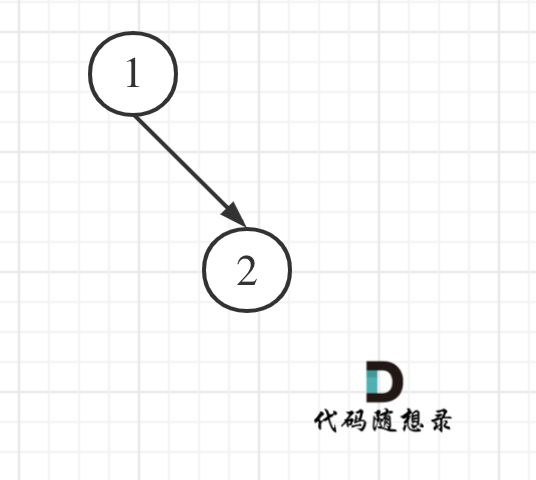
其实是0,因为这棵树根本没有左叶子!
但看这个图的左叶子之和是多少?
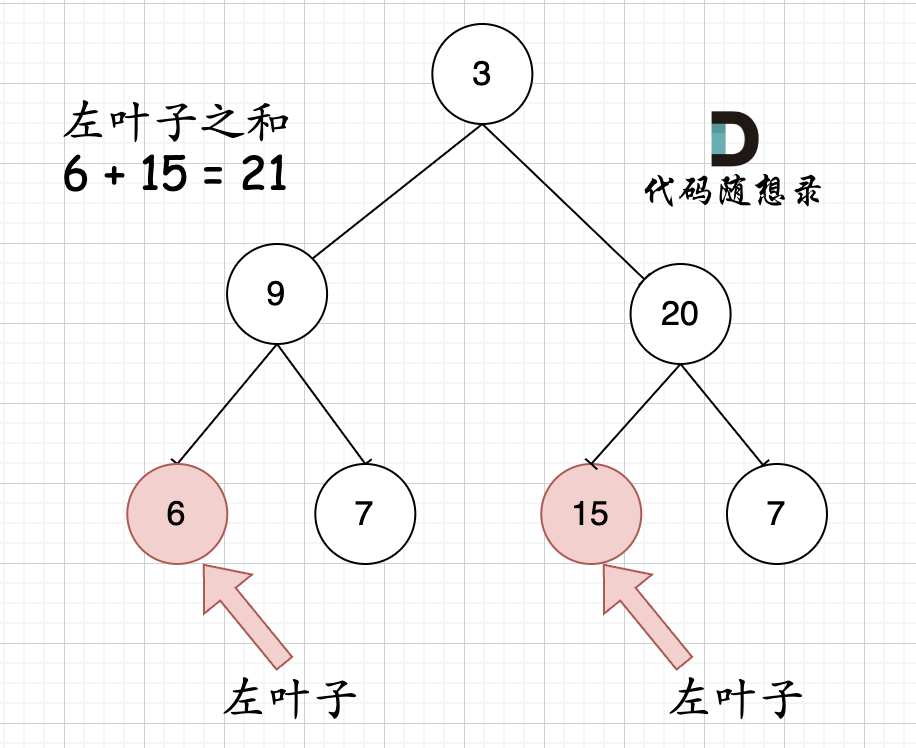
所以判断当前节点是不是左叶子是无法判断的,必须要通过节点的父节点来判断其左孩子是不是左叶子。
如果该节点的左节点不为空,该节点的左节点的左节点为空,该节点的左节点的右节点为空,则找到了一个左叶子,判断代码如下:
if (node->left != NULL && node->left->left == NULL && node->left->right == NULL) {
左叶子节点处理逻辑
}
2
3
# 3、递归写法
递归的遍历顺序为后序遍历(左右中),是因为要通过递归函数的返回值来累加求取左叶子数值之和。
递归三部曲:
# 确定递归函数的参数和返回值
判断一个树的左叶子节点之和,那么一定要传入树的根节点,递归函数的返回值为数值之和,所以为int
使用题目中给出的函数就可以了。
# 确定终止条件
如果遍历到空节点,那么左叶子值一定是0
if (root == NULL) return 0;
- 注意,只有当前遍历的节点是父节点,才能判断其子节点是不是左叶子。 所以如果当前遍历的节点是叶子节点,那其左叶子也必定是0,那么终止条件为:
if (root == NULL) return 0;
if (root->left == NULL && root->right== NULL) return 0; //其实这个也可以不写,如果不写不影响结果,但就会让递归多进行了一层。
2
# 3. 确定单层递归的逻辑
当遇到左叶子节点的时候,记录数值,然后通过递归求取左子树左叶子之和,和右子树左叶子之和,相加便是整个树的左叶子之和。
代码如下:
int leftValue = sumOfLeftLeaves(root->left); // 左
if (root->left && !root->left->left && !root->left->right) {
leftValue = root->left->val;
}
int rightValue = sumOfLeftLeaves(root->right); // 右
int sum = leftValue + rightValue; // 中
return sum;
2
3
4
5
6
7
8
- 整体递归代码如下:
int sumOfLeftLeaves(struct TreeNode* root){
//递归终止条件
if(root == NULL) return 0;
if(root->left==NULL && root ->right ==NULL) return 0;
//递归处理
int leftValue = sumOfLeftLeaves(root->left); //左
if(root->left != NULL && root->left->left ==NULL && root->left->right ==NULL)
// 左子树就是一个左叶子的情况
{
leftValue= root->left->val;
}
int rightValue = sumOfLeftLeaves(root->right); //右
int sum = leftValue + rightValue; //中
return sum;
}
2
3
4
5
6
7
8
9
10
11
12
13
14
15
16
17
18
- 以上代码精简之后如下:
int sumOfLeftLeaves(struct TreeNode* root){
//递归终止条件
if(root == NULL) return 0;
if(root->left==NULL && root ->right ==NULL) return 0;
int leftValue=0;
if(root->left != NULL && root->left->left ==NULL && root->left->right ==NULL)
{
leftValue= root->left->val;
}
return leftValue + sumOfLeftLeaves(root->left)+sumOfLeftLeaves(root->right);
}
2
3
4
5
6
7
8
9
10
11
12
13
- 精简之后的代码其实看不出来用的是什么遍历方式了,对于算法初学者以上根据第一个版本来学习。
# 4、迭代写法
# 4.1 层序遍历
int sumOfLeftLeaves(struct TreeNode* root){
int sum =0;
if(root==NULL) return sum;
struct TreeNode* queue[2000]; //大小给大点😂,不然测试代码不通过
int front=0,rear=0;
queue[rear++] = root;
while(front != rear){
int size = rear- front;
for(int i=0 ;i<size;i++){
struct TreeNode* node = queue[front++];
//判断当前节点是否有左叶子节点
if(node->left!=NULL&& node->left->left == NULL && node ->left ->right ==NULL){
sum+= node->left->val;
}
if(node->left) queue[rear++] = node ->left;
if(node->right) queue[rear++] = node ->right;
}
}
return sum;
}
2
3
4
5
6
7
8
9
10
11
12
13
14
15
16
17
18
19
20
21
22
23
# 4.2 深度遍历
//以下是后序遍历的写法,注意我们是看处理节点的顺序里判断是说明遍历顺序的
int sumOfLeftLeaves(struct TreeNode* root){
int sum =0;
if(root==NULL) return sum;
struct TreeNode* stack[2000]; //大小给大点😂,不然测试代码不通过
int top=0;
stack[top++] = root;
while(top>0){
struct TreeNode* node = stack[top-1];
if(node != NULL){
top--;
stack[top++] = node; //中
stack[top++]= NULL;
if(node ->right) stack[top++] = node->right; //右
if(node ->left) stack[top++] = node->left; //左
}
else {
top--; //弹出NULL
node = stack[--top];//获取要处理的节点
if(node->left!=NULL&& node->left->left == NULL && node ->left ->right ==NULL){
sum+= node->left->val;
}
}
}
return sum;
}
2
3
4
5
6
7
8
9
10
11
12
13
14
15
16
17
18
19
20
21
22
23
24
25
26
27
28
# 十三、找树左下角的值
513. 找树左下角的值 - 力扣(LeetCode) (opens new window)
# 1、题目
- 给定一个二叉树的 根节点 root,请找出该二叉树的 最底层 最左边 节点的值。
- 假设二叉树中至少有一个节点。
示例 1: 输入: root = [2,1,3] 输出: 11
2
3
示例 2: 输入: [1,2,3,4,null,5,6,null,null,7] 输出: 71
2
3提示:
二叉树的节点个数的范围是 [1,10^4]
-2^31 <= Node.val <= 2^31 - 1
# 2、递归思路及写法
- 递归获取每个节点的深度,判断节点的深度,遇到深度更深的就记录该值,注意我们下面用的前序遍历,(中序遍历应该可以),后序遍历就不可以,因为相同深度的节点我们只记录第一个的值,(即最左),所以要先遍历左节点
//递归写法
void traversal(struct TreeNode * root,int depth , int *maxDepth ,int*result){
if(root->left ==NULL && root -> right ==NULL){ //中
//遇到深度更深的叶子节点就记录该节点的值
if(depth > *maxDepth){
*maxDepth =depth;
*result =root->val;
}
}
//我们要获取的是最底最左的节点值,所以应该先进左节点
if(root->left){ //左
depth++;
traversal(root->left,depth,maxDepth,result);
depth--;
}
if(root->right){ //右
depth++;
traversal(root->right,depth,maxDepth,result);
depth--;
}
return ;
}
int findBottomLeftValue(struct TreeNode* root){
int maxDepth = INT_MIN;
int result = 0;
//leetcode c好像不支持用全局变量,执行案例会成功,但是提交代码就会失败
//所以这里使用指针来操作变量值,所以我们要传入地址
traversal(root,0,&maxDepth,&result);
return result;
}
2
3
4
5
6
7
8
9
10
11
12
13
14
15
16
17
18
19
20
21
22
23
24
25
26
27
28
29
30
31
32
# 3、层序遍历
- 这个题的层序遍历比较简单
- 就正常层序遍历节点,注意我们这里层序遍历先进右节点,再进左节点就可以保证我们想要的值是最后进入队列的
//层序遍历写法
int findBottomLeftValue(struct TreeNode* root){
int result = 0;
if(root==NULL) {
return result=root->val;
}
struct TreeNode* queue[10000];
int front=0,rear=0;
queue[rear++] = root;
while(front != rear){
int size = rear - front;
for(int i=0;i<size;i++){
struct TreeNode* node = queue[front++];
//因为我们要的是最深层最左边的节点值,所以我们从右节点先进,就可以保证我们想要的值是最后进入队列的
if(node->right) queue[rear++] = node ->right;
if(node->left) queue[rear++] = node ->left;
}
if(front == rear) {
result = queue[front-1] ->val;
}
}
return result;
}
2
3
4
5
6
7
8
9
10
11
12
13
14
15
16
17
18
19
20
21
22
23
24
25
26
# 十四、路径总和
112. 路径总和 - 力扣(LeetCode) (opens new window)
代码随想录 (programmercarl.com) (opens new window)
# 1、题目
给你二叉树的根节点
root和一个表示目标和的整数targetSum。判断该树中是否存在 根节点到叶子节点 的路径,这条路径上所有节点值相加等于目标和targetSum。如果存在,返回true;否则,返回false。叶子节点 是指没有子节点的节点。
示例 1: 输入:root = [5,4,8,11,null,13,4,7,2,null,null,null,1], targetSum = 22 输出:true 解释:等于目标和的根节点到叶节点路径如上图所示。1
2
3
4
示例2: 输入:root = [1,2,3], targetSum = 5 输出:false 解释:树中存在两条根节点到叶子节点的路径: (1 --> 2): 和为 3 (1 --> 3): 和为 4 不存在 sum = 5 的根节点到叶子节点的路径。1
2
3
4
5
6
7示例 3: 输入:root = [], targetSum = 0 输出:false 解释:由于树是空的,所以不存在根节点到叶子节点的路径。1
2
3
4
# 2、递归思路及写法
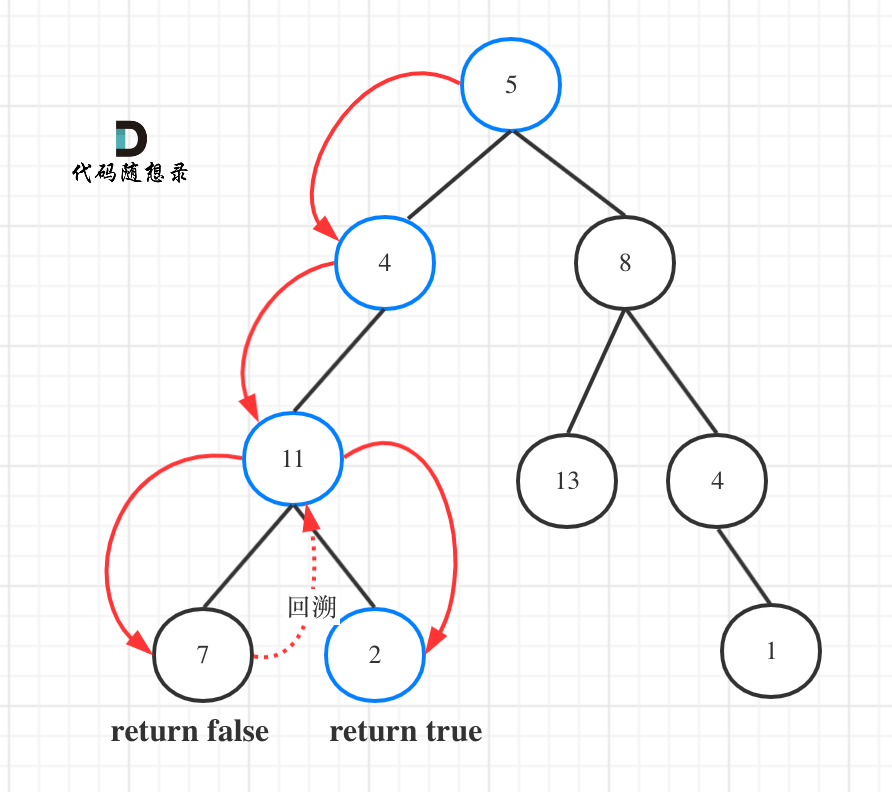
- 确定递归函数的参数和返回类型
图中可以看出,遍历的路线,并不要遍历整棵树,所以递归函数需要返回值,可以用bool类型表示。
所以代码如下:
bool traversal(treenode* cur, int count) // 注意函数的返回类型
- 确定终止条件
首先计数器如何统计这一条路径的和呢?
不要去累加然后判断是否等于目标和,那么代码比较麻烦,可以用递减,让计数器count初始为目标和,然后每次减去遍历路径节点上的数值。
如果最后count == 0,同时到了叶子节点的话,说明找到了目标和。
如果遍历到了叶子节点,count不为0,就是没找到。
递归终止条件代码如下:
if (!cur->left && !cur->right && count == 0) return true; // 遇到叶子节点,并且计数为0
if (!cur->left && !cur->right) return false; // 遇到叶子节点而没有找到合适的边,直接返回
2
- 确定单层递归的逻辑
因为终止条件是判断叶子节点,所以递归的过程中就不要让空节点进入递归了。
递归函数是有返回值的,如果递归函数返回true,说明找到了合适的路径,应该立刻返回。
代码如下:
if (cur->left) { // 左 (空节点不遍历)
// 遇到叶子节点返回true,则直接返回true
if (traversal(cur->left, count - cur->left->val)) return true; // 注意这里有回溯的逻辑
}
if (cur->right) { // 右 (空节点不遍历)
// 遇到叶子节点返回true,则直接返回true
if (traversal(cur->right, count - cur->right->val)) return true; // 注意这里有回溯的逻辑
}
return false;
2
3
4
5
6
7
8
9
整体代码:
class Solution {
private:
bool traversal(TreeNode* cur, int count) {
if (!cur->left && !cur->right && count == 0) return true; // 遇到叶子节点,并且计数为0
if (!cur->left && !cur->right) return false; // 遇到叶子节点直接返回
if (cur->left) { // 左
count -= cur->left->val; // 递归,处理节点;
if (traversal(cur->left, count)) return true;
count += cur->left->val; // 回溯,撤销处理结果
}
if (cur->right) { // 右
count -= cur->right->val; // 递归,处理节点;
if (traversal(cur->right, count)) return true;
count += cur->right->val; // 回溯,撤销处理结果
}
return false;
}
public:
bool hasPathSum(TreeNode* root, int sum) {
if (root == NULL) return false;
return traversal(root, sum - root->val);
}
};
2
3
4
5
6
7
8
9
10
11
12
13
14
15
16
17
18
19
20
21
22
23
24
25
精简写法:
bool hasPathSum(struct TreeNode* root, int targetSum){
// 递归结束条件:若当前节点不存在,返回false
if(!root)
return false;
// 若当前节点为叶子节点,且targetSum-root的值为0。(当前路径上的节点值的和满足条件)返回true
if(!root->right && !root->left && targetSum == root->val)
return true;
// 查看左子树和右子树的所有节点是否满足条件
return hasPathSum(root->right, targetSum - root->val) || hasPathSum(root->left, targetSum - root->val);
}
2
3
4
5
6
7
8
9
10
11
# 3、迭代思路及写法
- 构建一个结构体 Pair,用来存放节点,和到达对应节点的路径值
// 存储一个节点以及当前的和
struct Pair {
struct TreeNode* node;
int sum;
};
2
3
4
5
- 判断,若栈顶元素为叶子节点,且和为targetSum时,返回true
// 若栈顶元素为叶子节点,且和为targetSum时,返回true
if(!topPair.node->left && !topPair.node->right && topPair.sum == targetSum){
return true;
}
2
3
4
- 若当前栈顶节点有左右孩子,计算和并入栈
if(topPair.node->left) {
struct Pair newPair = {topPair.node->left, topPair.sum + topPair.node->left->val};
stack[stackTop++] = newPair;
}
if(topPair.node->right) {
struct Pair newPair = {topPair.node->right, topPair.sum + topPair.node->right->val};
stack[stackTop++] = newPair;
}
2
3
4
5
6
7
8
整体代码:
// 存储一个节点以及当前的和
struct Pair {
struct TreeNode* node;
int sum;
};
bool hasPathSum(struct TreeNode* root, int targetSum){
struct Pair stack[1000];
int stackTop = 0;
// 若root存在,则将节点和值封装成一个pair入栈
if(root) {
struct Pair newPair = {root, root->val};
stack[stackTop++] = newPair;
}
// 当栈不为空时
while(stackTop) {
// 出栈栈顶元素
struct Pair topPair = stack[--stackTop];
// 若栈顶元素为叶子节点,且和为targetSum时,返回true
if(!topPair.node->left && !topPair.node->right && topPair.sum == targetSum)
return true;
// 若当前栈顶节点有左右孩子,计算和并入栈
if(topPair.node->left) {
struct Pair newPair = {topPair.node->left, topPair.sum + topPair.node->left->val};
stack[stackTop++] = newPair;
}
if(topPair.node->right) {
struct Pair newPair = {topPair.node->right, topPair.sum + topPair.node->right->val};
stack[stackTop++] = newPair;
}
}
return false;
}
2
3
4
5
6
7
8
9
10
11
12
13
14
15
16
17
18
19
20
21
22
23
24
25
26
27
28
29
30
31
32
33
34
35
36
# 4、自己瞎写
- 自己一开始看这道题时,瞎写的解法
bool recursion(struct TreeNode* root, int targetSum,int curSum){
if(root == NULL){
return false;
}
curSum += root->val;
if(root->left==NULL && root->right==NULL && curSum == targetSum){
return true;
}
return recursion(root->left,targetSum,curSum) || recursion(root-> right,targetSum,curSum);
}
bool hasPathSum(struct TreeNode* root, int targetSum){
if(root ==NULL){
return 0;
}
return recursion(root,targetSum,0);
}
2
3
4
5
6
7
8
9
10
11
12
13
14
15
16
17
18
# 十五、路径总和2
# 1、题目
给你二叉树的根节点 root 和一个整数目标和 targetSum ,找出所有 从根节点到叶子节点 路径总和等于给定目标和的路径。
叶子节点 是指没有子节点的节点。
示例1: 输入:root = [5,4,8,11,null,13,4,7,2,null,null,5,1], targetSum = 22 输出:[[5,4,11,2],[5,8,4,5]]1
2
3
示例2: 输入:root = [1,2,3], targetSum = 5 输出:[]1
2
3示例3: 输入:root = [1,2], targetSum = 0 输出:[]1
2
3提示:
- 树中节点总数在范围
[0, 5000]内-1000 <= Node.val <= 1000-1000 <= targetSum <= 1000
# 2、思路
创建一个栈和结果队列(二维数组)
递归进入直到最后一层,判断sum数组是否是为指定路劲总和,是就将栈中的元素拷贝个结果数组
递归:
- 传入参数
void traversal(struct TreeNode *root,int targetSum,int * returnSize,int** returnColumnSizes,int**result,int* stack,int top,int sum)1- 结束条件
//结束条件 if(root ==NULL) return ;1
23.递归处理
sum += root->val; stack[top] = root->val; if(root->left==NULL && root ->right==NULL && sum == targetSum){ //申请空间 result[*returnSize] = (int*)malloc(sizeof(int)*(top+1)); //拷贝内容 memcpy(result[*returnSize],stack,sizeof(int)*(top+1)); (* returnColumnSizes)[*returnSize] = top +1; *returnSize = *returnSize +1; }1
2
3
4
5
6
7
8
9
10
# 3、代码
/**
* Definition for a binary tree node.
* struct TreeNode {
* int val;
* struct TreeNode *left;
* struct TreeNode *right;
* };
*/
/**
* Return an array of arrays of size *returnSize.
* The sizes of the arrays are returned as *returnColumnSizes array.
* Note: Both returned array and *columnSizes array must be malloced, assume caller calls free().
*/
void traversal(struct TreeNode *root,int targetSum,int * returnSize,int** returnColumnSizes,int**result,int* stack,int top,int sum){
//结束条件
if(root ==NULL) return ;
//执行条件
sum += root->val;
stack[top] = root->val;
if(root->left==NULL && root ->right==NULL && sum == targetSum){
//申请空间
result[*returnSize] = (int*)malloc(sizeof(int)*(top+1));
//拷贝内容
memcpy(result[*returnSize],stack,sizeof(int)*(top+1));
(* returnColumnSizes)[*returnSize] = top +1;
*returnSize = *returnSize +1;
}
//遍历左子树
traversal(root->left,targetSum,returnSize,returnColumnSizes,result,stack,top+1,sum);
//遍历右子树
traversal(root->right,targetSum,returnSize,returnColumnSizes,result,stack,top+1,sum);
}
int** pathSum(struct TreeNode* root, int targetSum, int* returnSize, int** returnColumnSizes) {
int ** result= (int**)malloc(sizeof(int *)*5000);
*returnColumnSizes =(int *)malloc(sizeof(int)*5000);
int stack[5000] = {0};
*returnSize =0;
traversal(root,targetSum,returnSize,returnColumnSizes,result,stack,0,0);
return result;
}
2
3
4
5
6
7
8
9
10
11
12
13
14
15
16
17
18
19
20
21
22
23
24
25
26
27
28
29
30
31
32
33
34
35
36
37
38
39
40
41
42
43
44
45
46
# 十六、最大二叉树
654. 最大二叉树 - 力扣(LeetCode) (opens new window)
# 1、题目
给定一个不重复的整数数组 nums 。 最大二叉树 可以用下面的算法从 nums 递归地构建:
创建一个根节点,其值为 nums 中的最大值。 递归地在最大值 左边 的 子数组前缀上 构建左子树。 递归地在最大值 右边 的 子数组后缀上 构建右子树。 返回 nums 构建的 最大二叉树 。
示例:1 输入:nums = [3,2,1,6,0,5] 输出:[6,3,5,null,2,0,null,null,1] 解释:递归调用如下所示: - [3,2,1,6,0,5] 中的最大值是 6 ,左边部分是 [3,2,1] ,右边部分是 [0,5] 。 - [3,2,1] 中的最大值是 3 ,左边部分是 [] ,右边部分是 [2,1] 。 - 空数组,无子节点。 - [2,1] 中的最大值是 2 ,左边部分是 [] ,右边部分是 [1] 。 - 空数组,无子节点。 - 只有一个元素,所以子节点是一个值为 1 的节点。 - [0,5] 中的最大值是 5 ,左边部分是 [0] ,右边部分是 [] 。 - 只有一个元素,所以子节点是一个值为 0 的节点。 - 空数组,无子节点。1
2
3
4
5
6
7
8
9
10
11
12
13
示例2: 输入:nums = [3,2,1] 输出:[3,null,2,null,1]1
2
3提示:
1 <= nums.length <= 10000 <= nums[i] <= 1000nums中的所有整数 互不相同
# 2、思路
- 找到数组最大值下标,切割左右数组
# 3、代码
struct TreeNode* constructMaximumBinaryTree(int* nums, int numsSize){
//如果数组大小为0,说明数组为空,返回 NULL
if(numsSize ==0){
return NULL;
}
//数组不为 NULL
int maxIndex = 0;
//找到数组中最大的数坐标,做为切割点
for(int i=1;i<numsSize;i++){
if(nums[i] > nums[maxIndex]){
maxIndex =i;
}
}
//开辟结点
struct TreeNode* node =(struct TreeNode*)malloc(sizeof(struct TreeNode));
node->val = nums[maxIndex];
//递归定义左孩子和右孩子
int rightSize = numsSize - maxIndex -1;
//切割左右数组
node->left = constructMaximumBinaryTree(nums,maxIndex);
node->right = constructMaximumBinaryTree(nums+maxIndex+1,rightSize);
return node;
}
2
3
4
5
6
7
8
9
10
11
12
13
14
15
16
17
18
19
20
21
22
23
24
25
26



